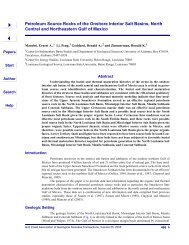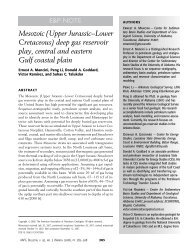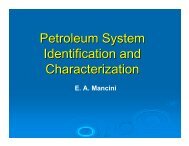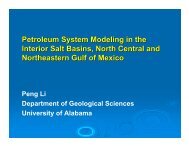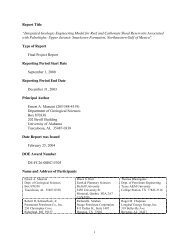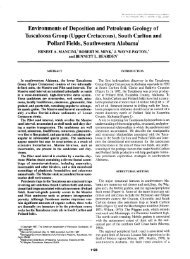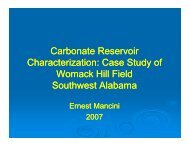Part 4 - Berg - Hughes Center
Part 4 - Berg - Hughes Center
Part 4 - Berg - Hughes Center
Create successful ePaper yourself
Turn your PDF publications into a flip-book with our unique Google optimized e-Paper software.
gas with some oil, not only within the Bossier shale, but also in overlying Upper Jurassic<br />
and Lower Cretaceous reservoirs, particularly in the Bossier and Cotton Valley.<br />
The Bossier petroleum system includes essentially the same underburden and<br />
overburden rocks as the Smackover petroleum system. The petroleum source rocks are<br />
the Bossier shale beds. Generation of hydrocarbons was initiated in the late Early<br />
Cretaceous with the generation of secondary, non-associated thermogenic gas<br />
commencing in the Late Cretaceous (Figs. 349-351). Hydrocarbon expulsion appears<br />
minimal suggesting the Bossier has potential as a shale gas reservoir (Fig. 352).<br />
Sandstones within the Bossier and in the Cotton Valley Group also probably acted as<br />
reservoirs for the hydrocarbons that were expelled from the Bossier shale beds.<br />
Hydrocarbon Flow Pathway Modeling<br />
Hydrocarbon flow pathway modeling indicates that Smackover hydrocarbons were first<br />
generated and expelled in the Early Cretaceous from the southern part of the North<br />
Louisiana Salt Basin and migrated north and updip into the areas of the Sabine Uplift,<br />
Monroe Uplift, and northern parts of the basin (Figs. 353-355). Hydrocarbons, essentially<br />
thermogenic gas, generated and expelled in the late Early Cretaceous from the Bossier<br />
followed the same flow pathways as Smackover hydrocarbons (Figs. 356-367). However,<br />
expulsion modeling (Fig. 352) indicates that much of the gas generated from the gas-<br />
prone Type III kerogen in this source rock was retained in the Bossier and was not<br />
expelled. The low total organic carbon content of the Bossier contributed to the<br />
accumulation of in situ thermogenic gas. The IES PetroMod® 2D software application<br />
was used for the hydrocarbon flow pathway modeling. No thermogenic hydrocarbon<br />
expulsion occurred in the immediate vicinity of the Monroe Uplift, and the main source<br />
416




